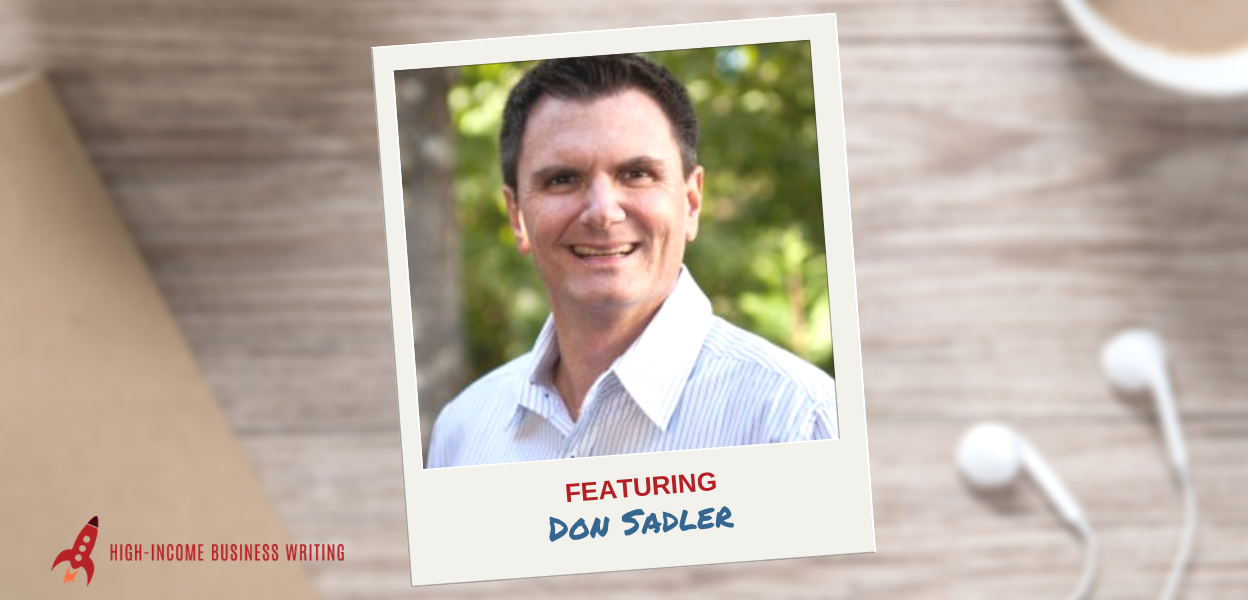If you’ve ever been laid off or downsized, you already know what a crappy experience that can be.
Especially when it’s unexpected and it catches you off guard.
But for Don Sadler, getting laid off from his job in 2009 was one of the best things that could have happened to him.
Don was able to turn this “misfortune” into a six-figure freelance business. And in this interview, he shares how he did this and what he’s learned along the way.
Lots of great ideas and insights in this episode — even for those of you who’ve been freelancing for a while.
The notes that follow are a very basic, unedited summary of the show. There’s a lot more detail in the audio version. You can listen to the show using the audio player below. Or you can subscribe in iTunes or on Stitcher to get this show delivered straight to the Podcasts app on your smart phone, tablet or iPod.


High-Income Business Writing with Ed Gandia
#048: From Laid-Off Worker to Six-Figure Freelance Writer
Tell us about yourself?
Don Sadler is a full time commercial freelance writer specializing in business and finance. He started his professional career in 1985, working for a newsletter publishing company. In 1997, he moved to different publishing company and started freelance writing on the side. In 2009, he was laid off and started freelancing full time.
How did you manage your workload when working full time and freelancing on the side?
Don’s freelance work was complementary to his 9-5 job. Both focused on the same content area. He was researching, writing and editing business topics in his day job and then writing business articles for B2B magazines in his spare time.
Give us an example of how you landed one of your first clients?
Don’s employer had a large bank as a client. The bank asked Don to interview someone at a commercial finance company. In course of working on the article, the finance company asked Don if he could help with its monthly newsletter. The company wanted someone who understood the topic—and Don had demonstrated that he did.
Don has been working with the finance company on a monthly retainer basis ever since.
Did you do any outbound prospecting in your first three or four years?
No. Don simply kept his eyes open for new opportunities, especially in the course of doing his day job.
Did you anticipate your freelancing becoming a full time business?
No. Don did it simply for supplementary income and personal satisfaction. He discovered he had an entrepreneurial bent.
When did you make the leap to full time freelance work?
In 2008, the financial services industry slowed. Don could see that he would eventually be laid off. In 2009, got the call.
As soon as he got off the phone, he emailed two of his freelance clients saying he was available, and they got back to him almost immediately. So Don started his lay off with paying work.
Freelancing on the side, while working full time, buys you freedom and guts. It’s an insurance policy. You can be bolder in your full-time job.
How is your business today?
By the end of his first year of full time self-employment, Don had replaced his old salary. In his second year, he exceeded six figures. His income has grown every year since.
How do you minimize income peaks and valleys?
Ongoing, steady clients are better than one-time clients. Try to land clients that send you work every month for a set amount of money. Look for ongoing projects, such as newsletters, blogs and ghostwritten articles.
What is the fee range for newsletter projects?
Don charges about $2000 to write a four page, quarterly newsletter.
Tell us how you find new opportunities and evaluate prospects.
Don knows a lot of people and institutions in the financial services industry. Many of his best clients come from his past job. But even if you haven’t been in a particular job or industry for a long time, you probably still have something you can leverage.
Where else do you find new clients?
Outside of existing contacts, Don finds prospects through his website. Once he rewrote his home page for SEO, he started getting good leads. SEO works particularly well for Don because he works in a niche area.
How do you uncover new opportunities with existing clients?
If you do a good job for a large institution, it can often lead to new opportunities within that institution. Your contact will refer you to his/her colleagues. If you can the job well, don’t need much hand-holding and are fun and pleasant to work with, they’ll refer you along.
What have you done to boost your internal hourly earnings?
Don realized that as a self-employed professional service provider, his time is his inventory. And it’s very important to track your inventory. He tracks his time in 15-minute increments in a MS Word document.
At the end of every day, he knows how many hours he’s spent on which projects and how much money he’s earned.
What’s your take on hourly versus project pricing?
No successful freelance writer will quote a price of $150 an hour. Clients are simply going to have a difficult time accepting that. But if you price your work on a project basis, you can earn as much as you want per hour. It all depends on how quickly you do the work.
But the only way to know how much you’re making internally on your work is to track your time. When you price your work by the hour, you limit on how much money you can earn.
Where can we learn more about you?
And while you’re there, make sure to sign up for Don’s monthly e-newsletter on content marketing.
Want More of This Stuff?
Want to get more tips and strategies for boosting your writing income? There are three ways you can enjoy these tips and strategies, share them with friends and help me grow this movement to banish the starving writer syndrome:
- Sign up for this podcast on iTunes. Click here to subscribe to the podcast on iTunes.
- Subscribe to this podcast through the Podcast app on your iPhone or Android phone (free from the app store).
- Leave a review — Share an honest sentence or two about the show on
the iTunes page and give it a star rating (this makes a HUGE difference in helping others find the show). - Share the love — Share this episode with friends and colleagues. An easy way to do that is by using the social media buttons down below.
Finally, if you have a question you’d potentially like answered on a future show —or if you’d like to be considered as a guest for a future episode — please let me know: ed at b2blauncher dot com.
Thanks again for your support!
Till next time,
-Ed






